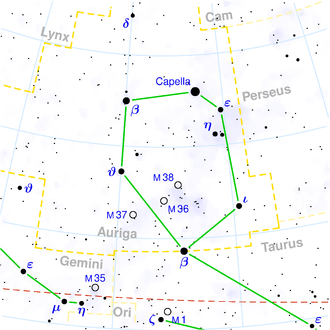Almaaz
|
Double star Almaaz (ε Aurigae) |
|||||||||||||||||||||
|---|---|---|---|---|---|---|---|---|---|---|---|---|---|---|---|---|---|---|---|---|---|
| AladinLite | |||||||||||||||||||||
|
Observation dates equinox : J2000.0 , epoch : J2000.0 |
|||||||||||||||||||||
| Constellation | Carter | ||||||||||||||||||||
| Right ascension | 05 h 01 m 58.13 s | ||||||||||||||||||||
| declination | + 43 ° 49 ′ 23.9 ″ | ||||||||||||||||||||
| Apparent brightness | 3.03 (2.92 to 3.83) mag | ||||||||||||||||||||
| Typing | |||||||||||||||||||||
| B − V color index | +0.54 | ||||||||||||||||||||
| U − B color index | +0.33 | ||||||||||||||||||||
| R − I index | +0.45 | ||||||||||||||||||||
| Spectral class | F0 Ia | ||||||||||||||||||||
| Variable star type | EA / GS | ||||||||||||||||||||
| Astrometry | |||||||||||||||||||||
| Radial velocity | (−10.4 ± 0.4) km / s | ||||||||||||||||||||
| parallax | (2.41 ± 0.51) mas | ||||||||||||||||||||
| distance | (approx. 1300) ly approx. 400 pc |
||||||||||||||||||||
| Visual absolute brightness M vis | −5.95 mag | ||||||||||||||||||||
| Proper movement | |||||||||||||||||||||
| Rec. Share: | (−0.86 ± 1.38) mas / a | ||||||||||||||||||||
| Dec. portion: | (−2.66 ± 0.75) mas / a | ||||||||||||||||||||
| Physical Properties | |||||||||||||||||||||
| Effective temperature | 7800 K | ||||||||||||||||||||
|
Other names and catalog entries |
|||||||||||||||||||||
|
|||||||||||||||||||||
| annotation | |||||||||||||||||||||
|
|||||||||||||||||||||
Almaaz (from Arabic الماعز, DMG al-māʿiz 'goat (nbock)'; also Al Anz or Haldus ) is the name of the star ε Aurigae (Epsilon Aurigae) in the constellation Fuhrmann .
Overview
Almaaz is an eclipse-shifting star of the Algol type about 1,300 light years away. At around 27 years (9892 days), ε Aurigae has a very long period for stars with variable eclipses. A special feature of the supergiant of the spectral class F0 are the type and duration of the coverage, which suggest a very large companion.
Exploring the system
The first eclipse of Almaaz was observed in 1821 by the German amateur astronomer JH Fritsch , making this star one of the first eclipsing stars to be discovered. The periodicity of the light curve was, however, only proven and examined by Hans Ludendorff in 1903 . The coverage phase lasts a total of exactly two years, the minimum between the so-called second and third contact lasts about 330 days. The last occultation started in 2009 and lasted until 2011.
For a long time, little was known about the nature of the secondary component because it could not be observed. It was only the explanation for the periodic darkening of the main component. One suspected, however, that it is a binary star system in a dark cloud. Direct observation of the course of the eclipse in 2009 showed that a dark disk of dust surrounding a small, invisible star is passing in front of Epsilon Aurigae. This was achieved with the help of the Michigan Infra-Red Combiner (MIRC), an interferometer that combines the light from four individual telescopes of the CHARA array at Georgia State University .
Mass of stars
Earlier studies assumed a very massive main component with 15 M ☉ or more, later studies suggested a model with significantly lower mass components as an alternative. Thanks to observation with the astrometry satellite Gaia , the distance to the system can be narrowed down much more than before. Based on the now favored distance of around 1300 light years, the lower-mass model seems to be preferred. Accordingly, the main component has a mass of only 2.2 M ☉ , while the darker secondary component would have 5.9 M ☉ and would therefore be more massive. However, further measurements are likely to be necessary before the system is fully understood.
Web links
- The Secret of the Fading Star - Astronomy Picture of the Day, Jan. 8, 2010.
Individual evidence
- ↑ a b eps Aur. In: SIMBAD . Center de Données astronomiques de Strasbourg , accessed June 13, 2020 .
- ↑ a b c Hipparcos catalog (ESA 1997)
- ↑ a b c eps Aur. In: VSX. AAVSO , accessed June 13, 2020 .
- ↑ a b c Bright Star Catalog
- ↑ Pulkovo radial velocities for 35493 HIP stars
- ^ Hipparcos, the New Reduction (van Leeuwen, 2007)
- ↑ Almaaz. Jim Kaler, accessed June 13, 2020 .
- ↑ Epsilon Aurigae. AAVSO , accessed June 13, 2020 .
- ↑ Mystery of the star eclipse solved. April 8, 2010, accessed June 13, 2020 .
- ^ Brian Kloppenborg et al .: Infrared images of the transiting disk in the ε Aurigae system . In: Nature . 464, 2010, pp. 870-872. doi : 10.1038 / nature08968 .
- ↑ P. Chadima et al .: Spectral and photometric analysis of the eclipsing binary epsilon Aurigae prior to and during the 2009-2011 eclipse . In: Astronomy & Astrophysics . 530, No. 530, 2011, p. A146. arxiv : 1105.0107 . bibcode : 2011A & A ... 530A.146C . doi : 10.1051 / 0004-6361 / 201116739 .
- ^ Solving the 200-Year-Old Mystery of a Strange Eclipsing Star. Space.com, June 18, 2018, accessed June 13, 2020 .

